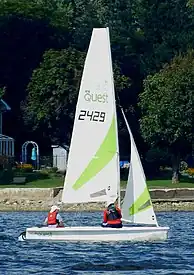 | |
| Development | |
|---|---|
| Designer | Jo Richards |
| Location | United Kingdom |
| Year | 2015 |
| Builder(s) | RS Sailing |
| Name | RS Quest |
| Boat | |
| Displacement | 309 lb (140 kg) |
| Draft | 3.57 ft (1.09 m) with centreboard down |
| Hull | |
| Type | monohull |
| Construction | Comptec PE3 polyethylene |
| LOA | 14.07 ft (4.29 m) |
| Beam | 6.00 ft (1.83 m) |
| Hull appendages | |
| Keel/board type | centreboard |
| Rudder(s) | transom-mounted rudder |
| Rig | |
| Rig type | Bermuda rig |
| Sails | |
| Sailplan | fractional rigged sloop |
| Mainsail area | 90 sq ft (8.4 m2) |
| Jib/genoa area | 29 sq ft (2.7 m2) |
| Spinnaker area | 107 sq ft (9.9 m2) |
| Gennaker area | 118 sq ft (11.0 m2) |
| Upwind sail area | 119 sq ft (11.1 m2) |
| Downwind sail area | 235 sq ft (21.8 m2) |
The RS Quest is a British sailboat that was designed by Jo Richards as a sail trainer and day sailer. It was first built in 2015.[1][2][3][4]
Production
The design has been built by RS Sailing in the United Kingdom, since September 2015 and remains in production.[1][2][5][6][7]
Design
The boat was designed for the British Sea Cadets to replace their existing fleet of older boats and also as a family day sailer.[2]
The RS Quest is a recreational sailing dinghy, with the hull built predominantly of rotomoulded Comptec PE3 polyethylene. It has a fractional sloop rig with aluminum spars and wire standing rigging. The hull has a nearly-plumb stem, a vertical transom, a transom-hung aluminum rudder controlled by a tiller and a retractable glassfibre centreboard. It displaces 309 lb (140 kg) and can carry 805 lb (365 kg) of crew weight or four adults.[1][2][3]
The boat has a draft of 3.57 ft (1.09 m) with the centreboard extended. Retracting the centreboard allows operation in shallow water, beaching or ground transportation on a trailer.[8]
The boat may be optionally fitted with a small outboard motor for docking and maneuvering. The maximum power is 3.35 hp (2 kW) and maximum motor weight is 33 lb (15 kg).[8]
Optional equipment includes a polyethylene foredeck, trapeze, an outboard motor mount, a launching dolly and a boat trailer for ground transport.[2]
For sailing downwind the design may be equipped with a optional symmetrical spinnaker of 107 sq ft (9.9 m2) or an asymmetrical spinnaker of 118 sq ft (11.0 m2).[1][2]
The boat's hull is 100% recyclable and the box it is shipped in is 100% recyclable material, made from 100% managed woodland materials, with a high percentage of previously recycled material. The hull wrapping material is biologically-based, made from 51% sugar cane waste, officially classified in the UK as paper and is also 100% recyclable.[8]
See also
References
- 1 2 3 4 McArthur, Bruce (2020). "RS Quest sailboat". sailboatdata.com. Archived from the original on 10 September 2022. Retrieved 11 September 2022.
- 1 2 3 4 5 6 RS Sailing (2022). "RS Quest". rssailing.com. Archived from the original on 10 September 2022. Retrieved 11 September 2022.
- 1 2 "RS Quest". Boat-Specs.com. 2022. Archived from the original on 11 September 2022. Retrieved 11 September 2022.
- ↑ "Jo Richards". Boat-Specs.com. 2022. Archived from the original on 27 July 2022. Retrieved 11 September 2022.
- ↑ McArthur, Bruce (2021). "RS Sailing". sailboatdata.com. Archived from the original on 28 July 2022. Retrieved 11 September 2022.
- ↑ "RS Sailing". Boat-Specs.com. 2022. Archived from the original on 11 September 2022. Retrieved 11 September 2022.
- ↑ "RS Quest". Cruising World. 20 July 2015. Archived from the original on 11 September 2022. Retrieved 11 September 2022.
- 1 2 3 RS Sailing (July 2022). "Owner's Manual, Version 12" (PDF). rssailing.com. Archived (PDF) from the original on 10 June 2022. Retrieved 11 September 2022.